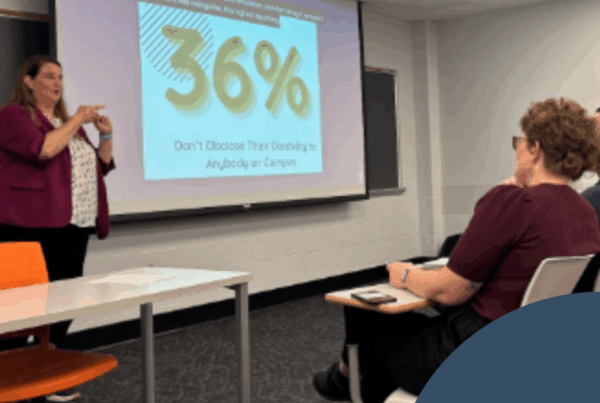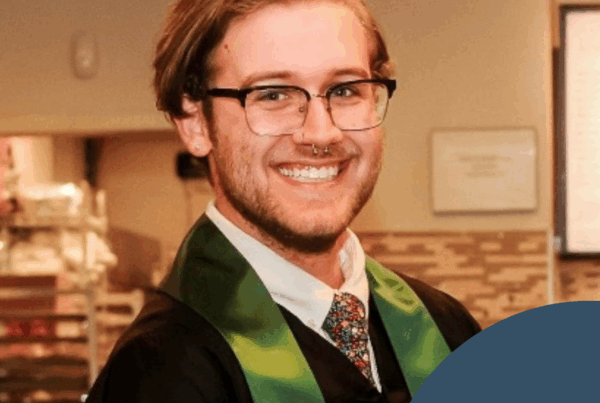Summary
The National Disability Center’s second year marked major research milestones, national partnerships, and expanded outreach, all focused on understanding and improving the experiences of disabled college students.

The National Disability Center for Student Success officially launched on August 1, 2023, with a mission to improve postsecondary outcomes for students with disabilities through research, leadership, and collaboration. Led by Principal Investigator and Executive Director Stephanie W. Cawthon, PhD, the Center remains on track to meet its five-year goals under the federally funded IES Cooperative Agreement.
Building on Our Year One Foundation
Year One laid the groundwork for our success in Year Two. The development of the Campus Accessibility Measure (CAM) pilot, the launch of the Student Fellows mentorship model, and the Center’s first national Townhall helped establish a strong foundation for research and outreach. As a result, these early efforts shaped the Center’s approach and created momentum that continues to grow.
In Year Two, we expanded research, grew our team, and deepened partnerships to advance access.
Expanding the Team and Mentorship Model
Year Two welcomed three new Student Fellows: Maddy O’Grady, Ife Adekoya, and Nicole Garcia. Each fellow is paired with a Faculty Cadre mentor, continuing the Center’s mentorship model that emphasizes collaborative learning and leadership development.
“Working with Dr. Borrego as a mentor has expanded the way I approach research,” said Student Fellow Maddy O’Grady. “Our conversations helped me connect big-picture questions about faculty accessibility to the personal motivation and experiences of disabled students. Presenting at AERA 2025 made it even more clear how collaborative, student-centered research can shape real change.”
This mentorship model, highlighted in the Center’s Best Practice: Mentoring Disabled College Students, is designed to foster collaborative approaches and leadership growth. The model helps students and faculty build meaningful relationships that center disability experiences in higher education.
The Center also added a Social Media Coordinator, Preksha Pankaj Welankiwar, whose work strengthens outreach and engagement across platforms. Her role supports communications, but also helps amplify student voices and grow the national audience.
Together, these new team members bring fresh energy and insight to the Center’s mission. Their work supports leadership development, accessible research, and national impact.
Advancing Research Across Study Sets
The Center is conducting 10 Study Sets over five years. In Year Two, significant progress was made on the following:
- Secondary Data Analysis
Analysis of CCSSE’s 2020–2023 cohort focused on achievement, retention, and completion rates of students with disabilities. The article Developmental Course Taking and Academic Outcomes for Community College Students Who Use Disability Services showcases the findings of this completed study set. - Campus Accessibility Measure (CAM)
The Center developed, piloted, revised, and deployed CAM nationally. CCSSE has adopted a condensed Accessibility Module based on this measure for use in their 2025 data collection efforts, including new demographic items related to disability. Findings from this work were published in the Center’s National Report on Disabled College Student Experiences, which highlights key insights into campus accessibility, student disclosure, and the use of accommodations. - Design Studies
These studies examine student success initiatives and their impact on disabled students. Initial work focused on programs at The University of Texas at Austin, identifying pain points and administrative decision-making processes. At least four studies will inform outreach and training efforts at institutions nationwide, including a focus on internship programs, STEM, and more. - Systematic Literature Review
This review explores the impact of online learning on disabled students in higher education, focusing on research published between 2020 and 2024. This review is an opportunity to better understand the impact of technology in the window between COVID-19 and the onset of AI-based tools.
Events and Engagement Highlights
In Year Two, the Center expanded its national presence through a series of events designed to share research, foster dialogue, and build community.
For instance, the Center participated in the American Educational Research Association (AERA) 2025 conference, showcasing multiple projects and engaging with scholars and practitioners across the country. Thus, helping elevate the visibility of disability-focused research and created new opportunities for collaboration.
The Center also hosted two Townhalls. The Fall 2024 Townhall introduced the Center’s first research review and the early research findings for the Campus Accessibility Measure, while the Spring 2025 Townhall focused on digital content accessibility and practical strategies for higher education institutions. Both Townhalls welcomed national audiences and encouraged feedback and shared learning.
In addition to the Townhalls, the Center produced two webcast events that offered deeper dives into specific topics. The Fall 2024 Disability on Campus webcast, explored student experiences and institutional responses, while the Spring 2025 Practical Teaching Tips webcast, provided actionable strategies for instructors seeking to improve accessibility in their classrooms.
These events reflect the Center’s commitment to transparency, collaboration, and ongoing dialogue with the higher education community.
Looking Ahead to Year Three
As the Center enters its third year, the focus will be on faculty accessibility research, targeted outreach, and utilizing new tools to support training and dissemination.
Results from the Faculty Accessibility Measure (FAM) will be released, adding a new dimension to the Center’s research on instructor practices and accessibility. Also, the Student Interview Project will expand, continuing to center student voices and lived experiences in the research process. We are also diving deeper into our research on disability disclosure, a critical part of the academic journey for disabled students in postsecondary education.
Additionally, the Center’s Learning Hub will expand to include brand new online training modules, updated research summaries, and practical strategies for higher education professionals.
New Townhalls and webcasts will offer opportunities to share research updates and gather feedback. To view any of the previous Townhalls, explore the Townhalls page. The Center will also participate in the ASHE conference and has submitted five proposals to present at AERA 2026. Updates will be shared once selections are confirmed.
Social media will play a larger role in outreach, with more videos, student fellow spotlights, and content focused on mentorship, accessibility, and research dissemination. Furthermore, the Center will continue to grow its Communications Network and collaborate with new partners to expand its reach and impact.
Finally, Year Three builds on past momentum with a focus on access and student success. We look forward to engaging with you and continuing to create the first actionable research foundation for disabled student success in postsecondary settings.


